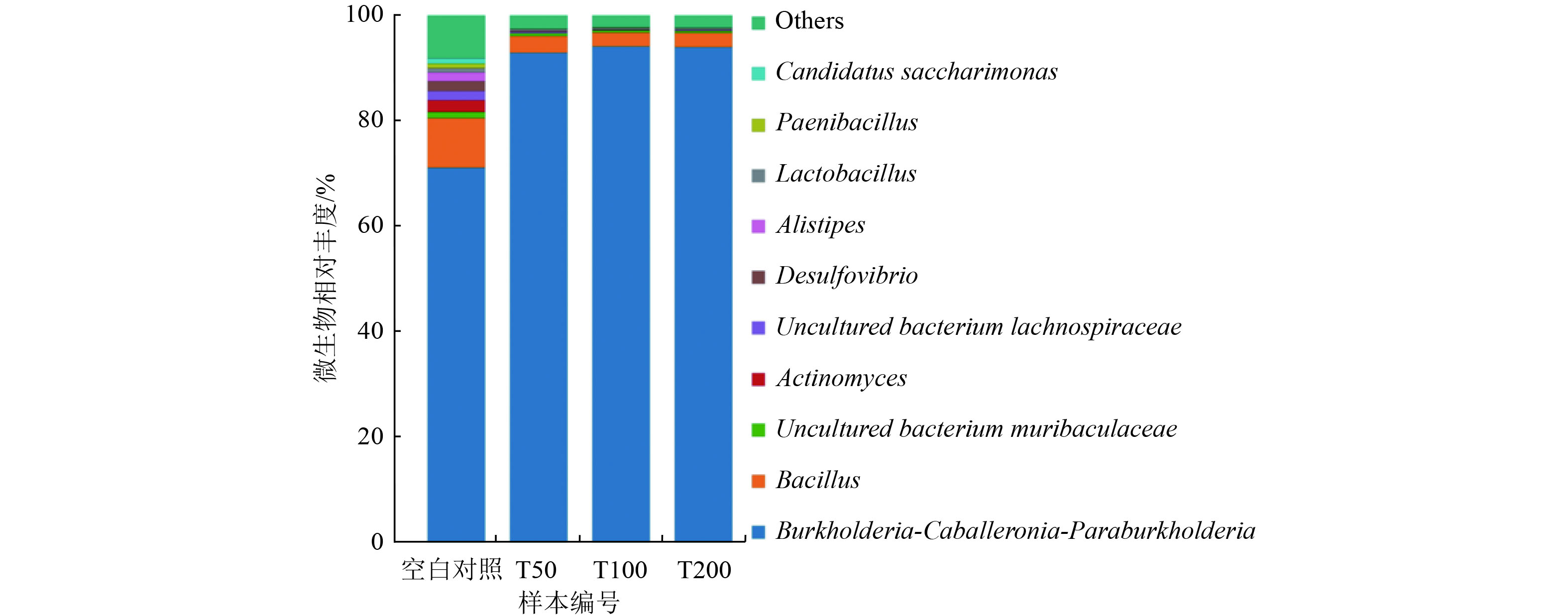Field testing of pilot-scale bioslurry reactor for coking contaminated site: a case study in Anhui Province
-
摘要:
多环芳烃(PAHs)尤其是高环PAHs作为焦化污染场地的特征污染物,是一种高毒性、难降解的污染物。生物泥浆生物反应器技术由于具有较高的可调控性,且对难溶解有机物的去除效果好,是一种具有工程化前景的土壤修复工艺。采用自主研发的1 m3泥浆反应罐和商业化的PAHs降解菌剂,在代表性污染土壤进行中试试验,探索了接种菌剂后微生物群落结构变化、优化含固率和微生物反应关键参数的波动范围。结果表明:微生物在营养物质的刺激下,第3~6周快速增殖,其中Hydrogenophaga、Sphingomonadaceae、Pseudomonas等菌属增殖明显,可能参与了PAHs的降解;具有代表性的高环PAHs污染物苯并[a]蒽、苯并[b]荧蒽、苯并[a]芘浓度从几倍于GB 36600—2018《土壤环境质量 建设用地土壤污染风险管控标准(试行)》一类建设用地的管控目标值降至修复目标值以下。针对国内缺少实际场地中试规模数据的问题,获得可靠的泥浆反应器运行数据,有助于推动泥浆生物反应器技术在国内向工程化规模扩展。
-
关键词:
- 多环芳烃(PAHs) /
- 生物降解 /
- 泥浆反应器 /
- 中试 /
- 焦化污染场地
Abstract:Polycyclic aromatic hydrocarbons (PAHs), especially high-molecular-weight PAHs, are the characteristic pollutants in coking contaminated sites, which are documented as highly toxic and recalcitrant to degrade. Due to the high controllability and high efficiency for insoluble organic pollutants, bioslurry reactor technology is a promising engineering process for soil remediation. To explore the variations of microbial communities after inoculation, and optimize the fluctuation range of solid content and the key parameters of microbial reaction, a self-developed 1 m3 slurry reactor tank combined with commercialized PAHs-degrading agent was adopted to conduct a pilot test at a representative contaminated field. The results showed that the microorganisms grew rapidly at the 3rd to 6th week under the stimulation of nutrients, reflected by the obvious proliferation of genus such as Hydrogenophaga, Sphingomonadaceae, and Pseudomonas, which were likely involved in the degradation of PAHs. Meanwhile, the concentrations of representative high molecular weight PAHs, namely benzo[a]anthracene, benzo[b]fluoranthene and benzo[a]pyrene, were reduced from several times the control target of Class 1 of building land in Soil Environmental Quality Risk Control Standard for Soil contamination of Development Land (Trial) (GB 36600-2018) to below the target value. In view of the lack of actual site pilot scale data in China, this study obtained reliable bioslurry reactor operation data and promoted the technology to engineering scale in China.
-
表 1 试验土壤污染情况
Table 1. Contamination level of sampling soil
mg/kg 污染物 样品1 样品2 一类建设用地标准 Zn 51.0 45.0 15 017 Pb 29.0 28.0 400 As 14.7 15.0 20 石油烃 408.0 460.0 826 苯并[a]蒽 12.1 15.5 5.5 苯并[b]荧蒽 31.7 40.1 5.5 苯并[k]荧蒽 31.0 39.2 55 苯并[a]芘 20.8 25.9 0.55 二苯并[a,h]蒽 6.7 9.3 0.55 茚并[1,2,3-cd]芘 23.0 27.8 5.5 表 2 菌剂多样性分析
Table 2. Analysis of microbial diversity
样品 生物多样性指数 ACE Chao1 Simpson Shannon 空白对照 309.53 309.38 0.49 2.51 T50 281.03 280.64 0.14 0.78 T100 283.77 285.61 0.11 0.67 T200 284.54 285.88 0.12 0.68 -
[1] 李伟, 王华伟, 孙英杰, 等. 焦化场地多环芳烃(PAHs)污染特征和修复技术研究进展[C]//中国环境科学学会2022年科学技术年会: 环境工程技术创新与应用分会场论文集(一). 北京: 中国环境科学学会, 2022. [2] TUHULOULA A, ALTWAY A, JULIASTUTI S R, et al. Biodegradation of soils contaminated with naphthalene in petroleum hydrocarbons using bioslurry reactors[J]. IOP Conference Series: Earth and Environmental Science,2018,175:012014. doi: 10.1088/1755-1315/175/1/012014 [3] 刘磊, 李习武, 刘双江, 等.降解多环芳烃的菌株Gordonia sp. He4的分离鉴定及其在菲污染土壤修复过程中的动态变化[J]. 环境科学,2007,28(3):617-622.LIU L, LI X W, LIU S J, et al. Isolation and identification of a PAHs-degrading strain Gordonia sp. He4 and its dynamics during bioremediation of phenanthrene polluted soil[J]. Chinese Journal of Environmental Science,2007,28(3):617-622. [4] 钱林波, 元妙新, 陈宝梁.固定化微生物技术修复PAHs污染土壤的研究进展[J]. 环境科学,2012,33(5):1767-1776.QIAN L B, YUAN M X, CHEN B L. Research progress about bioremediation of polycyclic aromatic hydrocarbons contaminated soil with immobilized microorganism technique[J]. Chinese Journal of Environmental Science,2012,33(5):1767-1776. [5] 王凌文. 表面活性剂强化微生物修复典型有机物污染场地/土壤[D]. 杭州: 浙江大学, 2016. [6] FORJÁN R, LORES I, SIERRA C, et al. Bioaugmentation treatment of a PAH-polluted soil in a slurry bioreactor[J]. Applied Sciences,2020,10(8):2837. doi: 10.3390/app10082837 [7] PELAEZ A I, LORES I, SOTRES A, et al. Design and field-scale implementation of an "on site" bioremediation treatment in PAH-polluted soil[J]. Environmental Pollution,2013,181:190-199. doi: 10.1016/j.envpol.2013.06.004 [8] 曹斐姝, 陈建平, 谢冬燕, 等.泥浆生物反应器在土壤修复中的应用[J]. 环境工程,2022,40(4):174-181.CAO F S, CHEN J P, XIE D Y, et al. Application of slurry bioreactor in soil remediation[J]. Environmental Engineering,2022,40(4):174-181. [9] LAUNEN L A, BUGGS V H, EASTEP M E, et al. Bioremediation of polyaromatic hydrocarbon-contaminated sediments in aerated bioslurry reactors[J]. Bioremediation Journal,2002,6(2):125-141. doi: 10.1080/10588330208951209 [10] BOLYEN E, RIDEOUT J R, DILLON M R, et al. Reproducible, interactive, scalable and extensible microbiome data science using QIIME 2[J]. Nature Biotechnology,2019,37(8):852-857. doi: 10.1038/s41587-019-0209-9 [11] CALLAHAN B J, McMURDIE P J, ROSEN M J, et al. DADA2: high-resolution sample inference from Illumina amplicon data[J]. Nature Methods,2016,13(7):581-583. doi: 10.1038/nmeth.3869 [12] GRICE E A, KONG H H, CONLAN S, et al. Topographical and temporal diversity of the human skin microbiome[J]. Science,2009,324:1190-1192. doi: 10.1126/science.1171700 [13] 侯晓鹏, 李春华, 叶春, 等.不同电子受体作用下微生物降解多环芳烃研究进展[J]. 环境工程技术学报,2016,6(1):78-84.HOU X P, LI C H, YE C, et al. Research progress of biodegradation of polycyclic aromatic hydrocarbons with amendment of different electron acceptors[J]. Journal of Environmental Engineering Technology,2016,6(1):78-84. [14] VERA A, WILSON F P, CUPPLES A M. Predicted functional genes for the biodegradation of xenobiotics in groundwater and sediment at two contaminated naval sites[J]. Applied Microbiology and Biotechnology,2022,106(2):835-853. doi: 10.1007/s00253-021-11756-3 [15] LI Y T, ZHENG B P, YANG Y H, et al. Soil microbial ecological effect of shale gas oil-based drilling cuttings pyrolysis residue used as soil covering material[J]. Journal of Hazardous Materials,2022,436:129231. doi: 10.1016/j.jhazmat.2022.129231 [16] DOSANI M, PLATT J. Pilot-scale demonstration of a slurry-phase biological reactor for creosote-contaminated soil: applications analysis report[R]. Cincinnati: IT Corp, 1993. [17] YU C C, CHANG T C, LIAO C S, et al. A comparison of the microbial community and functional genes present in free-living and soil particle-attached bacteria from an aerobic bioslurry reactor treating high-molecular-weight PAHs[J]. Sustainability,2019,11(4):1088. doi: 10.3390/su11041088 [18] SMITH E, THAVAMANI P, RAMADASS K, et al. Remediation trials for hydrocarbon-contaminated soils in arid environments: evaluation of bioslurry and biopiling techniques[J]. International Biodeterioration & Biodegradation,2015,101:56-65. [19] AHMED F, FAKHRUDDIN A. A review on environmental contamination of petroleum hydrocarbons and its biodegradation[J]. International Journal of Environmental Sciences & Natural Resources,2018,11(3):1-7. [20] YAN Z S, ZHANG Y, WU H F, et al. Isolation and characterization of a bacterial strain Hydrogenophaga sp. PYR1 for anaerobic pyrene and benzo[a] pyrene biodegradation[J]. RSC Advances,2017,7(74):46690-46698. doi: 10.1039/C7RA09274A [21] 王荔, 张腾飞, 杨苏才, 等.焦化厂PAHs污染土壤中微生物群落多样性特征[J]. 环境工程技术学报,2021,11(4):720-726.WANG L, ZHANG T F, YANG S C, et al. Characteristics of microbial community diversity in PAHs contaminated soil of a coking plant[J]. Journal of Environmental Engineering Technology,2021,11(4):720-726. [22] SWATI, MONI K, POOJA G, et al. Evaluation of a biosurfactant producing bacterial strain Pseudomonas sp. ISTPY2 for efficient pyrene degradation and landfill soil bioremediation through soil microcosm and proteomic studies[J]. Bioresource Technology Reports,2020,12:100607. doi: 10.1016/j.biteb.2020.100607 [23] LI L, SHEN X W, ZHAO C C, et al. Biodegradation of dibenzothiophene by efficient Pseudomonas sp. LKY-5 with the production of a biosurfactant[J]. Ecotoxicology and Environmental Safety,2019,176:50-57. doi: 10.1016/j.ecoenv.2019.03.070 [24] KUMARI S, MANGWANI N, DAS S. Synergistic effect of quorum sensing genes in biofilm development and PAHs degradation by a marine bacterium[J]. Bioengineered,2016,7(3):205-211. doi: 10.1080/21655979.2016.1174797 [25] STOLZ A. Molecular characteristics of xenobiotic-degrading sphingomonads[J]. Applied Microbiology and Biotechnology,2009,81(5):793-811. doi: 10.1007/s00253-008-1752-3 [26] OBAYORI O S, SALAM L B. Degradation of polycyclic aromatic hydrocarbons: role of plasmids[J]. Scientific Research and Essays,2010,5:4093-4106. [27] KERTESZ M A, KAWASAKI A, STOLZ A. Aerobic hydrocarbon-degrading alphaproteobacteria: sphingomonadales[C]//MCGENITY T. Taxonomy, genomics and ecophysiology of hydrocarbon-degrading microbes. Cham: Springer, 2019: 105-124. [28] PINYAKONG O, HABE H, OMORI T. The unique aromatic catabolic genes in sphingomonads degrading polycyclic aromatic hydrocarbons (PAHs)[J]. The Journal of General and Applied Microbiology,2003,49(1):1-19. doi: 10.2323/jgam.49.1 [29] LAFORTUNE I, JUTEAU P, DÉZIEL E, et al. Bacterial diversity of a consortium degrading high-molecular-weight polycyclic aromatic hydrocarbons in a two-liquid phase biosystem[J]. Microbial Ecology,2009,57(3):455-468. doi: 10.1007/s00248-008-9417-4 [30] 许华夏, 宋玉芳, 井欣, 等.生物泥浆反应器中微生物数量变化与PAHs降解[J]. 应用与环境生物学报,2000,6(5):452-456.XU H X, SONG Y F, JING X, et al. The variation of amount of microbes and its relations with the degradation of pahs in the bioslurry reactor[J]. Chinese Journal of Applied and Environmental Biology,2000,6(5):452-456. □ -





 下载:
下载:






